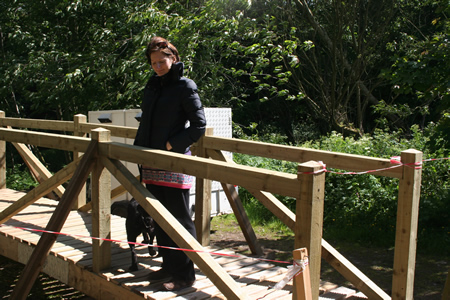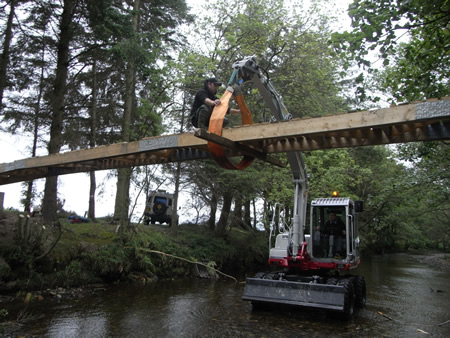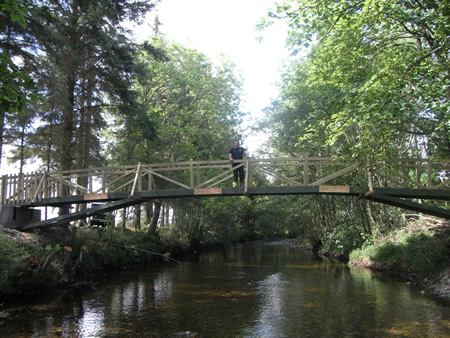These bulletin blogs represent news about Finavon and the South Esk, and my views as a riparian owner. They are not the views of any other organisation, nor are they designed to promote the interests of any individual or organisation other than Finavon Castle Water and factors affecting the fishery. Tony Andrews
This is the illustrated story of how a new footbridge, from the Red Brae track to Jock Barefoot’s Island, came to be built. It will be no surprise to regular visitors to FCW that the bridge is to be called “Jock Barefoot’s Bridge” after a young estate worker who unwisely cut a staff from a chestnut tree close to the great keep, known today as the Castle of Finavon. Unfortunately the laird was a brutal, cruel man called Earl Beardie, an early Lindsay, who wrought vengeance against the young man by hanging him from the same tree in punishment for his ‘crime’. Legend has it that Jock’s ghost still haunts the area around the confluence of the Lemno Burn with the River. Quite recently people have seen and felt the presence of his ghost, doubtless an anguished soul after his violent fate.
One of the impediments to enjoying a day’s fishing at Finavon has always been access to the north bank from the car park at the Red Brae. The lure of fishing the Red Brae pool from the north bank was often left unfulfilled because of high water making access impossible. Over the years we have had some nasty moments with fishermen struggling against the current in a rising river. Years ago Peter Reynard nearly drowned after becoming trapped in a rising river on a dark October evening. Fortunately Alasdair Petrie, the FCW ghillie, realised how serious the problem had become and made a heroic rescue of Peter in the nick of time. As a direct result of this incident we started dealing with this problem back in 1997 when we built the suspension footbridge linking the island (which we call ‘Jock Barefoot’s island’, but that is another story) with the north bank just upstream from Craigo Stream. That left the flood channel between the south bank and Jock Barefoot’s Island, and we all had to negotiate that gravel channel, which was mildly inconvenient in low water and difficult, bordering on dangerous, at higher river levels.
The completion of David’s Treehouse and the inviting walk down to Indies that opened up with its new access track, persuaded us that we should build a bridge over the flood channel high enough to keep the structure clear of spates. To say that it was a challenge to build a 20 metre single-span footbridge out of treated spruce timbers is an understatement. If I as the person who commissioned this amazing structure, lost a few hours of sleep over our decision to undertake this project, spare a thought for the designer and craftsman, Will Wells, who must have lost many nights to thinking about how the job might be done, and the risk of failure. I know he did, and it is a huge credit to him that he trusted in the innate qualities of wood and his own craftsmanship to deliver a singularly beautiful and remarkable bridge
Will and Andrew assembled the bridge in the Red Brae car park. Two spruce beams made from scarf-joined timbers, strengthened with nail plates (as used for roof trusses) and then fixed under compression in an arch were then joined together with diagonal cross beams and linked with deck planks. Finally 4×4 handrails gave the structure additional strength and rigidity, all under compression. It was possible for two or three people to walk ‘across’ the bridge in its car park location withouit much sign of a ‘bend’. Will pointed out that with the braces, under compression as well, supporting the bridge in its final position, its strength would be enhanced. Two wooden supports, where the braces were to slot into the bridge beams were then removed as a final test of the strength of the bridge. On dry land it all seemed to work. OK in harbour: now for the open sea!
Gail and Tally the labrador testing the bridge in the Red Brae car park
Will adjusting the position of the beams.
Getting the beams across was awkward but, once they were in position in their specially made steel brackets and joined together, the bridge was amazingly strong and could support the weight of Will and Andrew – plus a little help from the JCB with Dougie Ogilvy nursing the arched structure – strung like a spider’s web across the twenty metres of channel. Seeing it in position, looking so delicate and yet so obviously robust and strong, was a great sight, and celebrations were had at this first success!
Jock Barefoot’s Bridge – and Will Wells, designer and craftsman who built it.
This is the bridge across the flood channel linking Red Brae track with the island. You can now go from Milton of Finavon to Indies in your carpet slippers, not that you would want to! This bridge makes the final link for a very nice walk down the river to David’s Treehouse and further on to Indies.
TA


